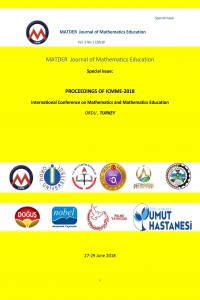Öz
In this study, it was aimed to comparatively examine
the students' ability to define and draw parallelogram for each class level.
Case study was chosen as the methodology of this study and the working group of
the study consists of 120 middle school students from a state middle school in
Turkey. Two open ended questions were used to gather data. One of the questions
was taken from the study of Fujita (2012) and other question was prepared by
researches after examining relevant literature, mathematics curricula and
textbooks. The document analysis method was used to analyze data. As a result
of the research, it was seen that students at all class levels drawn
prototype-parallelogram, and students at all class levels had difficulty in
defining parallelograms. It has been determined that students at all grade
levels cannot associate with the rhombus, a special form of parallelogram, and
do not prefer it in their drawings.
Anahtar Kelimeler
Kaynakça
- Akkaş, E. N., & Türnüklü, E. (2015). Ortaokul Matematik Öğretmenlerinin Dörtgenler Konusunda Pedagojik Alan Bilgilerinin Öğrenci Bilgisi Bileşeninde İncelenmesi [Middle School Mathematics Teachers’ Pedagogical Content Knowledge Regarding Student Knowledge about Quadrilaterals]. İlköğretim Online, 14(2), 744-756. Aktaş, M. C. (2016) Turkish high school students’ definitions for parallelograms: appropriate or inappropriate? International Journal of Mathematical Education in Science and Technology, 47(4), 583-596. Aktaş, M. C., & Aktaş, D. Y. (2012). Öğrencilerin Dörtgenleri Anlamaları: Paralelkenar Örneği [Students’ Understanding of Quadrilaterals: The Sample of Parallelogram]. Eğitim ve Öğretim Araştırmaları Dergisi, 1(2), 319–329. Akuysal, N. (2007). İlköğretim 7. Sınıf Öğrencilerinin 7. Sınıf Ünitelerindeki Geometrik Kavramlardaki Yanılgıları [Seventh Grade Students' Misconceptions about Geometrical Concepts]. Yüksek Lisans Tezi, Selçuk Üniversitesi, Eğitim Bilimleri Enstitüsü, Konya. Ayaz, Ü. B. (2016). Ortaokul Öğrencilerinin Dörtgenlere İlişkin Kavram İmajları [Middle School Students' Concept Images related to Quadrilaterals]. Yüksek Lisans Tezi, Necmettin Erbakan Üniversitesi, Eğitim Bilimleri Enstitüsü, Konya. Berkün, M. (2011). İlköğretim 5 ve 7. Sınıf Öğrencilerinin Çokgenler Üzerindeki İmgeleri ve Sınıflandırma Stratejileri [The Images of Polygons and Classification Strategies for the Primary School Students of 5th and 7th Grades]. Yüksek Lisans Tezi, Dokuz Eylül Üniversitesi, Eğitim Bilimleri Enstitüsü, İzmir. Clements, D. H., & Battista, M. T. (1992). Geometry and spatial understanding. Handbook of research mathematics teaching and learning. (Edt: D. A. Grouws). New York: McMillan Publishing Company. pp. 420-465. Cohen, L., Manion, L., & Morrison, K. (2000). Research methods in education. London: Routledge. De Villiers, M. (1994). The role and function of a hierarchical classification of quadrilaterals. For the Learning of Mathematics, 14(1), 11-18. Ergün, S. (2010). İlköğretim 7. Sınıf Öğrencilerinin Çokgenleri Algılama, Tanımlama ve Sınıflama Biçimleri [7th Grade Students' Perception, Definition and Classification of the Polygons]. Yüksek Lisans Tezi, Dokuz Eylül Üniversitesi, Eğitim Bilimleri Enstitüsü, İzmir. Erşen, Z. B., & Karakuş, F. (2013). Sınıf öğretmeni adaylarının dörtgenlere yönelik kavram imajlarının değerlendirilmesi [Evaluation of preservice elementary teachers’ concept images for quadrilaterals]. Turkish Journal of Computer and Mathematics Education, 4(2), 124-146. Fujita, T., & Jones, K. (2006). Primary trainee teachers’ understanding of basic geometrical figures in scotland. In J. Novotana, H. Moraova, K. Magdelena & N. Stehlikova (Eds.), Proceedings of The 30th Conference of the International Group for the Psychology of Mathematics Education, 3, 14-21. Fujita, T., & Jones, K. (2007). Learners’ understanding of the definitions and hierarchical classification of quadrilaterals: Towards a theoretical framing. Research in Mathematics Education, 9(1&2), 3-20. Fujita, T. (2012). Learners’ level of understanding of inclusion relations of quadrilaterals and prototype phenomenon. The Journal of Mathematical Behavior, 31, 60-72. Jones, K. (2002). Issues in the Teaching and Learning of Geometry. In: Linda Haggarty (Ed), Aspects of Teaching Secondary Mathematics: perspectives on practice. London: RoutledgeFalmer. Chapter 8, pp 121-139. ISBN: 0-415-26641-6). Karakuş, F., & Erşen, Z.B. (2016). Sınıf öğretmeni adaylarının bazı dörtgenlere yönelik tanımlama ve sınıflamalarının incelenmesi [Examining pre-service primary school teachers’ definitions and classifications towards quadrilaterals]. Karaelmas Journal of Educational Sciences, 4, 38-49. MEB. (2013). İlkokul matematik dersi 1-4. Sınıflar öğretim programı [Primary school mathematics curriculum (grades 1-4)].Ankara: MEB Talim ve Terbiye Kurulu Başkanlığı. MEB. (2015). Ortaokul matematik dersi 5-8. Sınıflar öğretim programı [Secondary school mathematics curriculum (grades 5-8)]. Ankara: MEB Talim ve Terbiye Kurulu Başkanlığı. Miles, M. B., & Huberman, A. M. (1994). Qualitative data analysis. Thousand Oaks, CA: Sage Publication. Nakahara, T. (1995). Children’s construction process of the concepts of basic quadrilaterals in Japan. In A. Oliver & K. Newstead (Eds.), Proceedings of the 19th Conference of the International Group for the Psychology of Mathematics Education, 3, 27-34. Okazaki, M., & Fujita,T. (2007). Prototype phenomena and common cognitive paths in the understanding of the ınclusion relations between quadrilaterals in Japan and Scotland. In H. Woo, K. Park & D. Seo (Eds.), Proceedings of The 31st Conference of the Internatıonal Group for the Psychology of Mathematics Education, 4, 41-48. Türnüklü, E., Alaylı, F.G., & Akkaş, E.N. (2013). İlköğretim matematik öğretmen adaylarının dörtgenlere ilişkin algıları ve imgelerinin incelenmesi [Investigation of prospective primary mathematics teachers’ perceptions and images for quadrilaterals]. Kuram ve Uygulamada Eğitim Bilimleri, 13(2), 1213-1232. Walcott, C., Mohr, D., & Kastberg, S.E. (2009). Making sense of shape: An analysis of children‟s written responses, Journal of Mathematical Behavior, 28, 30-40.
Ayrıntılar
| Birincil Dil | İngilizce |
|---|---|
| Bölüm | Makaleler |
| Yazarlar | |
| Yayımlanma Tarihi | 15 Eylül 2018 |
| Yayımlandığı Sayı | Yıl 2018 Cilt: 3 Sayı: 1 |


